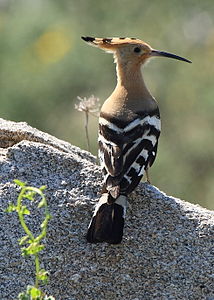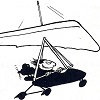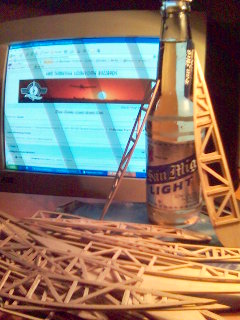|
|
 Stilson Stilson |
|
Flight Leader  Posts: 136
Time Online: 1 days 5 hours 36 minutes
|
For the last couple years while I've been working on my plane I've not been able to shake the idea of a set of smaller wings. I have to admit the red tail hawks in my grove aren't helping, every year I see the new fledglings with their oversized feathers fly around until their first moult, then they get their smaller feathers and speed up. It makes me wonder has anybody done it? A ground adjustable prop, a set of buzzard wings, and a set of barnswallow wings (figuratively, I don't mean swept etc, but maybe tapered) that can be swapped out seems to me like it would be the ticket to one step closer to a do all little plane..leisurely flying around the norm, but in about a half hour you can be ready to do a little cross country. Just thinking out loud... |
|
 Logged Logged |
|
|
|
|
 radfordc radfordc |
|
 Ace Ace Posts: 1,836
Time Online: 18 days 1 hours
|
Certainly, smaller wings could work. You might need to make other changes though. Things like airframe drag and engine power are important factors.
My Eindecker started life with a small wing of 92 sq. ft. of area. It was a dog and quite dangerous to fly! It tried to kill me when I inadvertently stalled and spun from about 500 ft while doing a simple banked turn. The problem was a too heavy plane with too much drag and too little power. Stall speed and cruise speed were close together. Stall at 45 and cruise at 55.
On the other hand my Sonex had a 98 sq. ft. wing and it flew very well with a more powerful engine and a cleaner airframe. Stall speed was 50 mph and cruise was 120 mph. |
|
|
|
|
|
 mullacharjak mullacharjak |
|
 Ace Ace Posts: 281
Time Online: 3 days 21 hours 12 minutes
|
There was a very nice Gentleman probably hungarian pkoszegi who if I am not wrong clipped his wings and installed a Rotax 532 engine.
He posted some details also.I am sure that was a fast aeroplane.He hasnt been heard since a Looong time.Hope he is ok.
Personaly I think the minimax is a MINi cost Maxi fun aeroplane for people on low budget.If I were to think of a budget hot rod aircraft it would
be a Corby Starlet.It can fly at upto 160mph on a VW engine. |
|
|
|
|
|
 Antoni Antoni |
|
 'Max, Chaser and Quik fan Ace Posts: 228
Time Online: 2 days 2 hours 53 minutes
|
There was a very nice Gentleman probably hungarian pkoszegi who if I am not wrong clipped his wings and installed a Rotax 532 engine.
He posted some details also. I am sure that was a fast aeroplane.He hasnt been heard since a Looong time. Hope he is ok.
Personaly I think the minimax is a MINi cost Maxi fun aeroplane for people on low budget.
I phoned him 2 or 3 years ago and took notes on his comments and numbers; speed climb and fuel. Can I find those notes now? Nope. I do remember the gist of what he said - that the aircraft flew like a brick with power off - and that he was happy with the way the aircraft flew. I remember thinking at the time that the numbers were 'good enough'. Minimax is a great low budget aircraft - so great that I'm on my third one despite my budget being not so low now. I just can't get away from the comfort of very friendly handling even when provoked, and the huge agility. |
|
|
|
|
|
 mullacharjak mullacharjak |
|
 Ace Ace Posts: 281
Time Online: 3 days 21 hours 12 minutes
|
|
|
|
|
|
 Bob Daly Bob Daly |
|
Ace
Posts: 888
Time Online: 45 days 22 hours 25 minutes
|
You should shorten the struts as well. Simply lopping off a foot or two would move the maximum bending moment of the main spar inboard and introduce a shear at the wing root. The strut should attach at 46% of the half span. |
|
 Logged Logged |
|
|
|
|
 Greg Doe Greg Doe |
|
Ace
Posts: 256
Time Online: 40 days 14 hours 20 minutes
|
When Wayne designed the Mini Max his biggest concerns were to not exceed the 254# max weight, and the 62 mph cruise. Had he known that there aren't any ultralight police with radar guns at 1000 ft. agl. he wouldn't have worried about the max cruise speed. If I wanted to make a faster Mini Max I would use a thinner airfoil. Glide ratio on a Max is about 4 1/2 to 1. With a shorter wing it will glide like a rock. With a thinner wing it will just glide faster. All things being equal, I certainly wouldn't sacrifice wing area to increase the speed on a Max. |
|
|
|
|
|
 PUFF PUFF |
|
 Ace Ace Posts: 1,518
Time Online: 34 days 6 hours 18 minutes
|
How about the other extreme. maybe adding a couple feet to a wing? What effect would that have? |
|
|
|
|
|
 Bob Daly Bob Daly |
|
Ace
Posts: 888
Time Online: 45 days 22 hours 25 minutes
|
I like Greg's suggestion. A thinner airfoil could also allow for a smaller horizontal tail, maybe cantilevered. In any case, increasing or decreasing span or changing airfoils or tail areas, one should be prepared for some stress analysis. Minor changes that amount to tweaks may be done but any attempt to significantly alter handling or performance needs calculations. Adding span would require lift and drag truss analysis and involve possible changes to the struts, spars and their carry-throughs, and tail surfaces. One would likely be doing at least 2/3's of the design work of a new airplane. |
|
 Logged Logged |
|
|
|
|
 lake_harley lake_harley |
|
Ace
Posts: 1,097
Time Online: 25 days 7 hours 59 minutes
|
I've always heard that one change leads to a lot of other changes. If a thinner airfoil is used that would also reduce the height of the spars and that would lead to considering and evaluating the construction of the spars to assure adequate strength.
Lynn |
|
|
|
|
|
 Stilson Stilson |
|
Flight Leader  Posts: 136
Time Online: 1 days 5 hours 36 minutes
|
Most certainly, I firmly believe any structural design change should only be done after a full stress analysis and proper design calculations with a healthy safety factor. its just the firewall forward, gauge, and hanger costs that keep me coming back to the idea. There is no way I'd ever rob the max to power another, but a second set of wings hanging in the hanger. Wouldn't cost much to build. I also completely agree with not just popping off a couple bays, it would have to be a new faster wing, though I think I would reduce the area, not the span, maybe up the wing loading to 10-12 pounds/ft^2.", nothing extreme. But then basically the entire structure has to be reevaluated, and by the time it's all done not worth it to do. Just with how easy the wings mount and dismount, if there was a set of "approved" plans, I'd buythem in heart beat. |
|
 Logged Logged |
|
|
|
|
 Cy V Cy V |
|
 Ace Ace Posts: 641
Time Online: 14 days 16 hours 49 minutes
|
I think I read (or saw in a YouTube video) once that Wayne just eyeballed the airfoil when he created it. He just drew it with a #2 pencil and that was that.
Was Wayne even an engineer? I mean that as a legitimate question. I have no idea. |
| Bad spellers of the world untie! |
|
|
|
|
|
 Greg Doe Greg Doe |
|
Ace
Posts: 256
Time Online: 40 days 14 hours 20 minutes
|
I don't think Wayne had an engineering degree? I'll ask skip, and get back to you. That being said, he had more common sense about what works, and what doesn't than a thousand engineers with a degree. Jim Cally (not sure if that is the correct spelling?) did a lot of the stress analysis on the Max. |
|
|
|
|
|
 radfordc radfordc |
|
 Ace Ace Posts: 1,836
Time Online: 18 days 1 hours
|
Somewhere there is a complete engineering analysis of the Minimax. I think it might be on line. |
|
|
|
|
|
 mullacharjak mullacharjak |
|
 Ace Ace Posts: 281
Time Online: 3 days 21 hours 12 minutes
|
How about the other extreme. maybe adding a couple feet to a wing? What effect would that have?
A very sane thought.Thats the true essence of the ultralight aircraft.Flying on low power.Hence you need a long wing.The aircraft of the Lympne trails in Engand 1924 fit that description.One aircraft The ANEC II had a wing span of 34 foot and flew on just a 750cc motorcycle engine.And it was not slow either. |
|
|
|
|
|
 Greg Doe Greg Doe |
|
Ace
Posts: 256
Time Online: 40 days 14 hours 20 minutes
|
For those who don't recognize the name of Harold (Skip) Little let me give some background. In addition to his other job at Arnold Engineering Center, Harold worked with TEAM from it's beginnings. I asked Skip if he knew if Wayne had an engineering degree, or any degree for that matter, and his answer was"not that I'm aware of".
In an earlier post I offered that Jim Collie had done the engineering analysis. Skip clarified that comment as well. He said that one year at the Oshkosh show there was an analysis paper handed out that Jim used to plug in the Mini Max figures. So Jim Collie did the stress analysis on all the TEAM designs by Wayne Ison, with the help of an outline. |
|
|
|
|
|
 Cy V Cy V |
|
 Ace Ace Posts: 641
Time Online: 14 days 16 hours 49 minutes
|
That's incredible that Wayne was able to design airplanes without any formal engineering training. Completely self-taught. Very impressive. It makes me wonder what he could've accomplished had he been an engineer...probably designing the space shuttle or rockets. |
| Bad spellers of the world untie! |
|
|
|
|
|
 Greg Doe Greg Doe |
| September 1, 2019, 3:22am |
|
Ace
Posts: 256
Time Online: 40 days 14 hours 20 minutes
|
Skip told me that Wayne worked for Goodyear, but didn't say what he did for them. I'm curious, so I will ask Harold the next time we talk. |
|
|
|
|
|
 Antoni Antoni |
| September 1, 2019, 7:30am |
|
 'Max, Chaser and Quik fan Ace Posts: 228
Time Online: 2 days 2 hours 53 minutes
|
Holding a degree proves that you are inherently able to or have been taught to think logically and work diligently. A degree in a relevant discipline will help too.
If you already have those qualities a degree will not help you much.
In the USA there's a very big emphasis on qualifications [of whatever true value] when it comes to deciding whether to employ someone for a job. Elsewhere in the world what you have already achieved matters more. |
|
|
|
|
|
 Arthur Withy Arthur Withy |
| September 1, 2019, 12:43pm |
|
 Happy 1500R owner - building a Jodel D18 Ace Posts: 2,532
Time Online: 32 days 12 hours 14 minutes
|
Degree or no degree...Wayne was a very clever hands on type of guy with insight and understanding on many issues. He did have a clear understanding of his aircraft and the engineering...and he did his homework.
We should all be very appreciative of what MR Ison has given us all. He was Clever and practical.
MY TWO CENTS
regards Arthur
|
|
|
|
|
|
 Arthur Withy Arthur Withy |
| September 1, 2019, 12:44pm |
|
 Happy 1500R owner - building a Jodel D18 Ace Posts: 2,532
Time Online: 32 days 12 hours 14 minutes
|
Degree or no degree...Wayne was a very clever hands on type of guy with insight and understanding on many issues. He did have a clear understanding of his aircraft and the engineering...and he did his homework.
We should all be very appreciative of what MR Ison has given us all. He was Clever and practical.
MY TWO CENTS
regards Arthur
|
|
|
|
|
|
 aeronut aeronut |
| September 1, 2019, 12:50pm |
|
 blue sky and tail winds to everyone Ace Posts: 1,560
Time Online: 28 days 22 hours 31 minutes
|
I believe that he also designed the early Fisher aircraft, FP-101 ect. Please correct me if I am wrong. |
| never surrender; never give-up |
|
|
|
|
|
 Phil Phil |
| September 1, 2019, 1:00pm |
|
 Ace Ace Posts: 1,071
Time Online: 15 days 4 hours 23 minutes
|
I believe that he also designed the early Fisher aircraft, FP-101 ect. Please correct me if I am wrong.
The FP-202 Koala, I 'd learned from their T.E.A.M. info-pack. |
|
|
|
|
|
 Bob Daly Bob Daly |
| September 2, 2019, 5:30pm |
|
Ace
Posts: 888
Time Online: 45 days 22 hours 25 minutes
|
The math required to design the Minimax is high school level. |
|
 Logged Logged |
|
|
|
|
 Stilson Stilson |
| September 2, 2019, 10:32pm |
|
Flight Leader  Posts: 136
Time Online: 1 days 5 hours 36 minutes
|
I will have to politely disagree. While I reluctantly agree that maybe the math is (personally though My high school didn't teach beam buckling computation, slugs as a unit, and I think it's a bit of a stretch to expect anywhere close to being able to evaluate flutter), I'm afraid of what would happen with nothing more than the coriculum knowledge without a lot of personal study or further education the first time it was pulled up to higher g's. The beam theory and material stress calculations probably omitted that the wings fail forward as the lift vector rotates over the front of the spar. (Atleast at my school they didn't teach Aerodynamics either). I think that it would be case of just enough information to be dangerous, the "unknown" unknowns is were the dangerous things happen.
Add to that, before the wonderful tool of excel spreadsheets, math could be a long tedious operation (while forces can be measured quite accurately with a drafting table and caliper) weight/balance calculations to come out in the end with an airframe that doesn't need ballasting, and do it all while staying under 254 pounds....I would say it is in my opinion that he did quite a good job.
(Edit..I do mean this politely, this thread may come up in search engine five years from now and somebody "who knows" they know what they are doing (even if they don't) might see it as their final reaffirmation that they are qualified to design their pallet wood airplane and fly it, probably west.....) |
|
 Logged Logged |
|
|
|
|
 Stilson Stilson |
| September 2, 2019, 10:45pm |
|
Flight Leader  Posts: 136
Time Online: 1 days 5 hours 36 minutes
|
|
 Logged Logged |
|
|
|
|
 Bob Daly Bob Daly |
| September 4, 2019, 9:44pm |
|
Ace
Posts: 888
Time Online: 45 days 22 hours 25 minutes
|
Even flutter and column buckling reduce to formulas which only require the user to plug in the appropriate values. Algebra, Geometry and Trigonometry arm the budding designer with the tools to design a safe airplane. I agree that Mr Ison did a great job but was he a prodigy? I don't think so. |
|
 Logged Logged |
|
|
|
|
|



